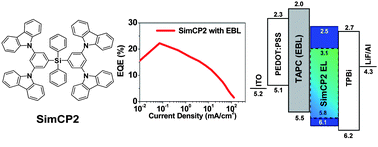We present a solution-processed blue organic light-emitting diode (OLED) with markedly high current efficiency of 41.2 cd A−1 at 100 cd m−2 and 31.1 cd A−1 at 1000 cd m−2. The high efficiency was partly attributed to the use of a molecular host, 3,5-di(9H-carbazol-9-yl)tetraphenylsilane, which possesses a wide triplet band gap, high carrier mobility, ambipolar transport property and high glass transition temperature. Besides the intrinsically good physical properties, the solution-process also played an important role in fabricating the high-efficiency device, since it could make the molecular distribution of host and guest homogeneous in the emissive layer. Moreover, the device efficiency at higher brightness could be markedly enhanced by using an electron-blocking layer. As the microlens was introduced on the glass substrate to enhance the light outcoupling, the resultant device efficiency of the blue OLED further increased to 50.1 cd A−1 at 100 cd m−2 and 37.3 cd A−1 at 1000 cd m−2.
You have access to this article
 Please wait while we load your content...
Something went wrong. Try again?
Please wait while we load your content...
Something went wrong. Try again?


 Please wait while we load your content...
Please wait while we load your content...